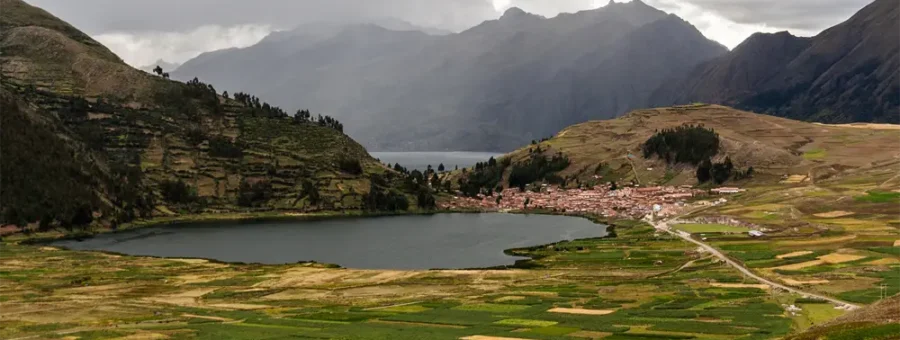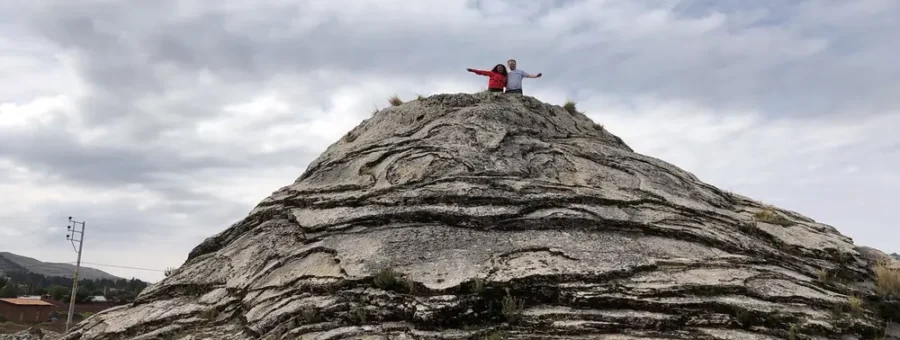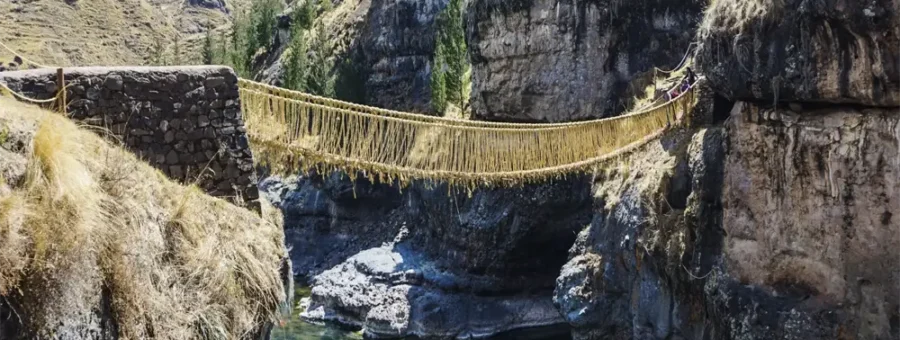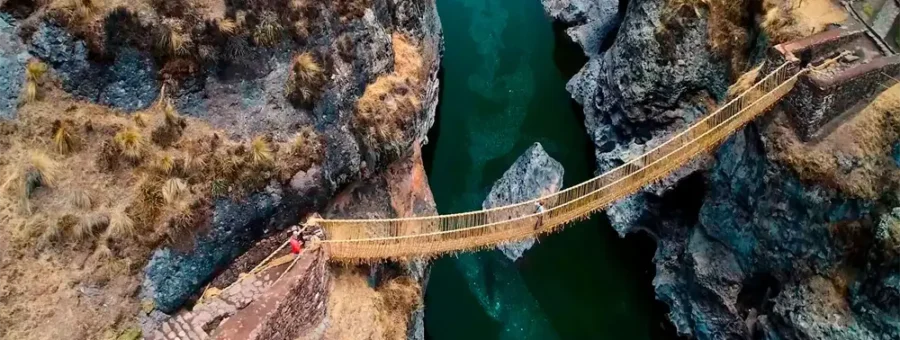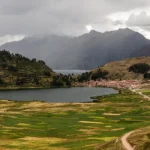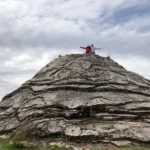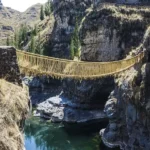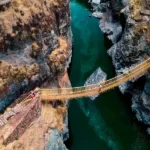DESCRIPCION
Q’eswachaka Bridge Tour | The Last Inca Bridge
The Q’eswachaka Bridge is one of the most authentic symbols of the living Andean culture. It is a unique suspension bridge, made entirely of ichu or q’oya, a plant fiber hand-woven using techniques inherited from the Incas. Every year, local communities perform an ancestral renewal ritual that has been recognized by UNESCO as Intangible Cultural Heritage of Humanity.
Visiting the Q’eswachaka Bridge is not just a tourist attraction, but also a way to delve into the history, the Andean worldview, and the strength of the community.
📍 Location of the Q’eswachaka Bridge
- Community: Quehue, Canas province, Cusco region.
- Distance from Cusco: 180 km (approx. 3.5 hours by car).
- Altitude: 3,700 m.a.s.l.
- Dimensions: 28 meters long, 1.2 meters wide, suspended 30 meters above the Apurímac River.
🌿 History and Living Tradition
The Q’eswachaka is part of the Qhapaq Ñan, the ancient Inca road system that connected the Empire. Unlike other Inca stone bridges, this one is kept alive thanks to community tradition.
Four communities Huinchiri, Chaupibanda, Choccayhua, and Ccollana-Quehue are responsible for its annual reconstruction. Women weave the ichu ropes, while men assemble the bridge under the guidance of the chakaruwak, the local master builder.
The ritual lasts three to four days (every second Sunday in June) and includes offerings to the Apus and Pachamama, the demolition of the old bridge, and a celebration with music, dance, and traditional foods. It is a minka, an Andean community service that strengthens social and identity ties.
🎉 Recognitions
- 2009: Declared a National Cultural Heritage Site (Peru).
- 2013: Inscribed on the Representative List of the Intangible Cultural Heritage of Humanity (UNESCO).
ITINERARY
🗺️ Detailed Itinerary – Q’eswachaka Tour from Cusco
🏨 Pickup from your hotel in Cusco
We start very early with pickup from your hotel or a prearranged point in the historic center of Cusco. Your guide will welcome you on this unique experience that will take us to the province of Canas, south of Cusco. During the journey, you will learn more about the living history of the Inca Empire and the roads that connected its four Sueños.
🚐 Panoramic trip through the Andes
The tour is carried out by private tourist transport along rural and Andean routes surrounded by mountains, valleys, and rivers. During the journey, your guide will share information about the Qhapaq Ñan, the impressive Inca road network declared a UNESCO World Heritage Site.
We will pass through villages such as Combapata, Yanaoca, and Cusipata, all marked by living traditions, agricultural landscapes, and the warmth of the local communities.
🍳 Typical Andean Breakfast in Cusipata
We will stop in the picturesque village of Cusipata, where a traditional breakfast prepared with local products awaits us: coffee, coca or muña infusions, artisan bread, homemade jams, and eggs cooked to order. This time also serves as a time to acclimatize before continuing to higher altitudes.
🌋 Visit to the Pabellones Volcano Viewpoint (Yanaoca)
We will continue the tour to the district of Yanaoca for a brief stop at the Pabellones Volcano viewpoint, a conical geological formation that emits steam during the rainy season, creating a surreal landscape. From this point, it is also possible to see herds of alpacas and llamas in their natural habitat.
Four Lagoons Circuit
We continue along one of the region’s most impressive natural routes: the Circuit of the Four High Andean Lagoons, surrounded by grasslands and mountains.
- Pampamarca Lagoon: with calm, blue-green waters.
- Asnacocha Lagoon: surrounded by mystery and veneration by the communities.
- Acopia Lagoon: refuge for high Andean birds such as huallatas and wild ducks.
- Pomacanchi Lagoon: the largest lagoon in the circuit, perfect for contemplating the reflection of the mountains and the sky.
These lagoons offer not only stunning landscapes but also a space to connect with the living nature of the Andes.
🌉 Arrival at the Q’eswachaka Inca Bridge – Intangible Cultural Heritage of Humanity
Finally, we arrive at the legendary Q’eswachaka Inca Bridge, suspended over the Apurímac River at more than 3,700 meters above sea level. This bridge, made entirely of ichu (high mountain straw), is the only one that continues to be rebuilt every year by the communities that inherited it from the Inca era: Huinchiri, Ccollana Quehue, Chaupibanda, and Choccayhua.
Accompanied by your guide, you will walk across the bridge and learn:
- Its connection to the Qhapaq Ñan.
- The symbolism of collective braiding.
- Details of the four-day reconstruction ritual.
- Why it was recognized by UNESCO as an Intangible Cultural Heritage of Humanity.
Walking across the bridge, if you wish, is an experience filled with emotion, respect, and ancestral connection.
🍽️ Local Community Lunch
We will enjoy a typical lunch prepared with local products, such as fresh trout, native potatoes, quinoa, and muña mate. This opportunity not only allows you to taste Andean cuisine, but also to support local communities through experiential tourism.
🚐 Return to Cusco
After a day filled with history, vibrant culture, and breathtaking landscapes, we begin the return journey to Cusco. Along the way, you can rest, reflect, or chat with your guide about the living traditions of the Andes.
We arrive in the afternoon, with drop-off at Plaza Regocijo, concluding a day filled with connection to Inca history.
INCLUDES
✅ What does the tour include?
🚐 Pickup from your hotel or central location in Cusco
On-time service in private tourist transportation, valid for hotels located in the historic center or surrounding areas.
🚌 Round-trip tourist transportation (Cusco – Q’eswachaka – Cusco)
Comfortable, safe, and authorized transportation for rural and high Andean routes, with panoramic windows and adequate spaces for groups.
🧭 Professional bilingual tour guide (Spanish/English)
Local guide specialized in Andean culture and Inca history, who accompanies you throughout the tour, explaining archaeological, geographical, and ritual aspects of the tour.
🥣 Andean breakfast in Cusipata
Includes coffee or coca tea, artisan bread, boiled or scrambled eggs, butter, jam, and seasonal fruits. Prepared in a local restaurant.
📸 Stop at the Pabellones Volcano viewpoint
Stop for photos and to observe a unique geological formation, with views of the highlands and native fauna.
🏞️ Panoramic Circuit of the Four High Andean Lagoons
Scenic tour of the Pampamarca, Asnacocha, Acopia, and Pomacanchi lagoons, with cultural and ecological explanations of the surroundings.
🌉 Admission to and guided tour of the Q’eswachaka Inca Bridge
Complete exploration of the Inca bridge of Ichu, with an explanation of the traditional renovation process, Quechua worldview, and community rituals.
🍽️ Local Andean lunch in a rustic restaurant
Traditional menu that may include trout, native potatoes, quinoa, salad, and coca or muña tea, prepared with fresh local produce.
🛟 Ongoing assistance throughout the tour
Support from the team of guides and drivers in case of any needs during the trip.
NOT INCLUDED
❌ What’s not included?
💼 Travel or personal insurance
Medical insurance is not included. It is recommended that you purchase travel insurance at your own expense.
🍬 Additional snacks or bottled drinks
It is recommended that you bring personal water, dried fruit, or additional snacks if you would like something during the trip.
💸 Voluntary tips for guides or the community
Not mandatory, but a very welcome gesture of gratitude from the local team and host families.
🧥 Personal items (raincoat, sunscreen, hat, etc.)
The tour does not include personal items. It is suggested that you bring a backpack with everything you need for the day.
📷 Photography equipment or personal cameras
Multimedia equipment is not provided. Visitors must bring their cell phone, camera, or drone if they wish to take photographs or record videos.
RECOMMENDATIONS
🌟 Recommendations
🧣 Dress in layers
During the hike, you will cross areas between 3,500 and 4,000 meters above sea level. Wear comfortable clothing, a windbreaker, light gloves, and a scarf or Andean hat.
👟 Comfortable shoes with non-slip soles
Some sections may have loose soil or rocks. Good sneakers or lightweight hiking boots will make a difference.
🌞 Sun and eye protection
Bring sunscreen, sunglasses, and a hat. Solar radiation at altitude can be strong even on cloudy days.
🧴 Hydration and personal snacks
Although the tour includes breakfast and lunch, it is recommended to bring a bottle of water, nuts, or energy bars for the trail.
📸 Camera with enough battery and memory
This tour offers multiple photo opportunities, from Andean landscapes to cultural portraits by the bridge.
❤️ Respect the environment and the communities
Q’eswachaka is not just a tourist attraction; it’s a living, sacred space with heritage value. Respect the rituals and customs, and don’t leave any trash behind.
FAQs
❓ Frequently Asked Questions
Do I need to be in good physical condition for this tour?
The tour doesn’t include long hikes or demanding activities, but it does reach high altitudes. It is suitable for most people in good general health.
Can I cross the Q’eswachaka Bridge?
Yes, it is possible to cross it under the supervision of a guide. The experience is optional and should be done with caution. It is not recommended for people with severe vertigo.
Is the tour available year-round?
Yes, although the best months are from April to November due to the dry climate. During the rainy season (December to March), the landscape is greener, but with higher humidity.
Is this a group or private tour?
This itinerary is a group service, but it can also be arranged privately by prior arrangement.
Which communities are involved in the reconstruction of the bridge?
The communities of Huinchiri, Chaupibanda, Ccollana Quehue, and Choccayhua keep the tradition of bridge weaving alive. Every year in June, they perform the ancestral reconstruction ritual.

